Comprehensive Analysis of Singapore's Economic Performance: 2005-2014
VerifiedAdded on 2023/01/19
|13
|2800
|34
Report
AI Summary
This report provides a comprehensive analysis of Singapore's economic performance from 2005 to 2014, examining key indicators across three major areas: output, labor market, and price levels. The analysis of output performance focuses on Real GDP, its growth, and per capita Real GDP, highlighting trends and the impact of the 2008 financial crisis. The report then delves into the labor market, assessing unemployment rates, the types of unemployment present, and the government's strategies for achieving full employment. Finally, it explores price level analysis, including inflation rates, the causes of inflation (demand-pull, cost-push, and imported inflation), and the government's measures to ensure price stability, primarily through monetary policy and exchange rate management. The report references economic data and government policies to provide a detailed understanding of Singapore's economic landscape during the specified period.
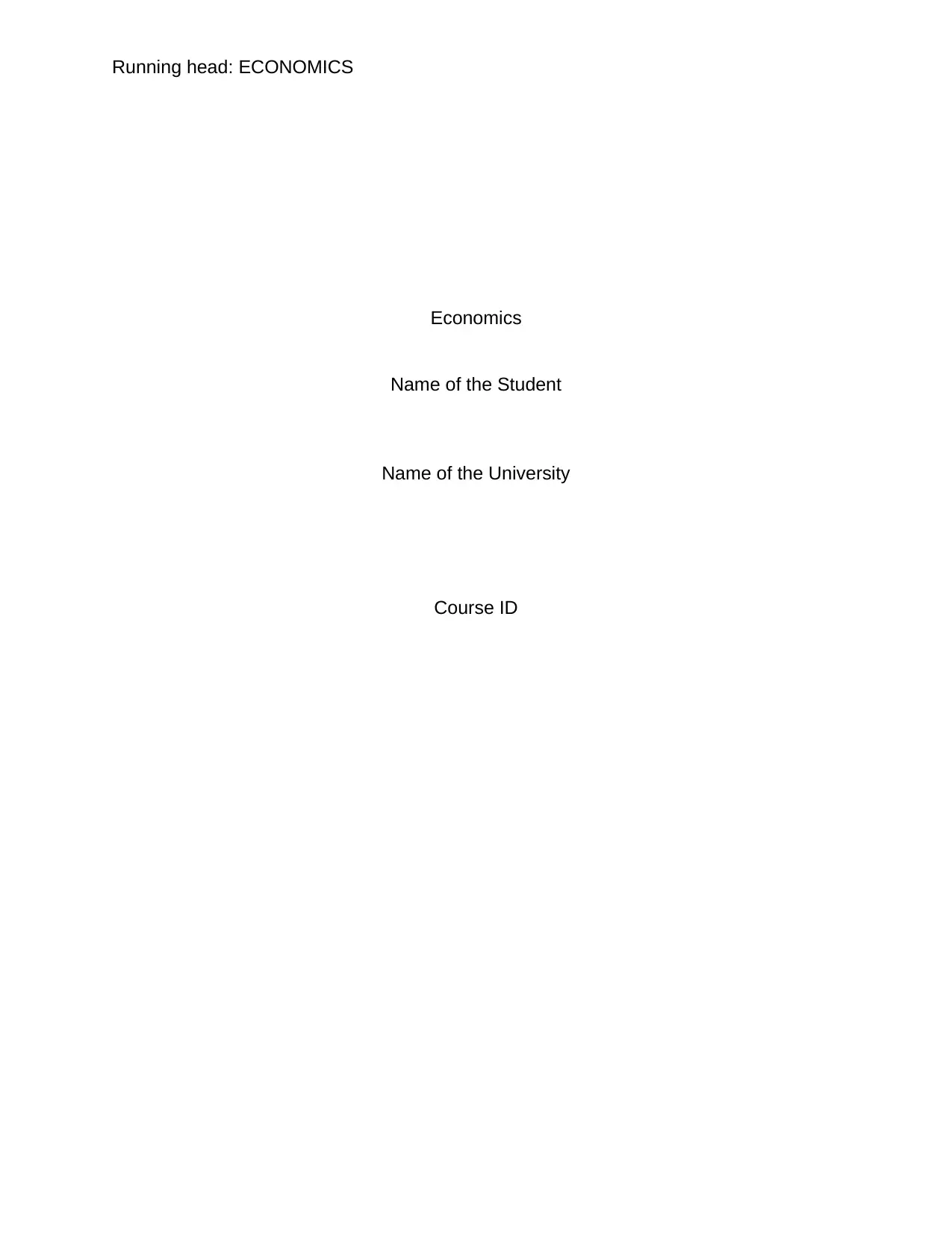
Running head: ECONOMICS
Economics
Name of the Student
Name of the University
Course ID
Economics
Name of the Student
Name of the University
Course ID
Paraphrase This Document
Need a fresh take? Get an instant paraphrase of this document with our AI Paraphraser
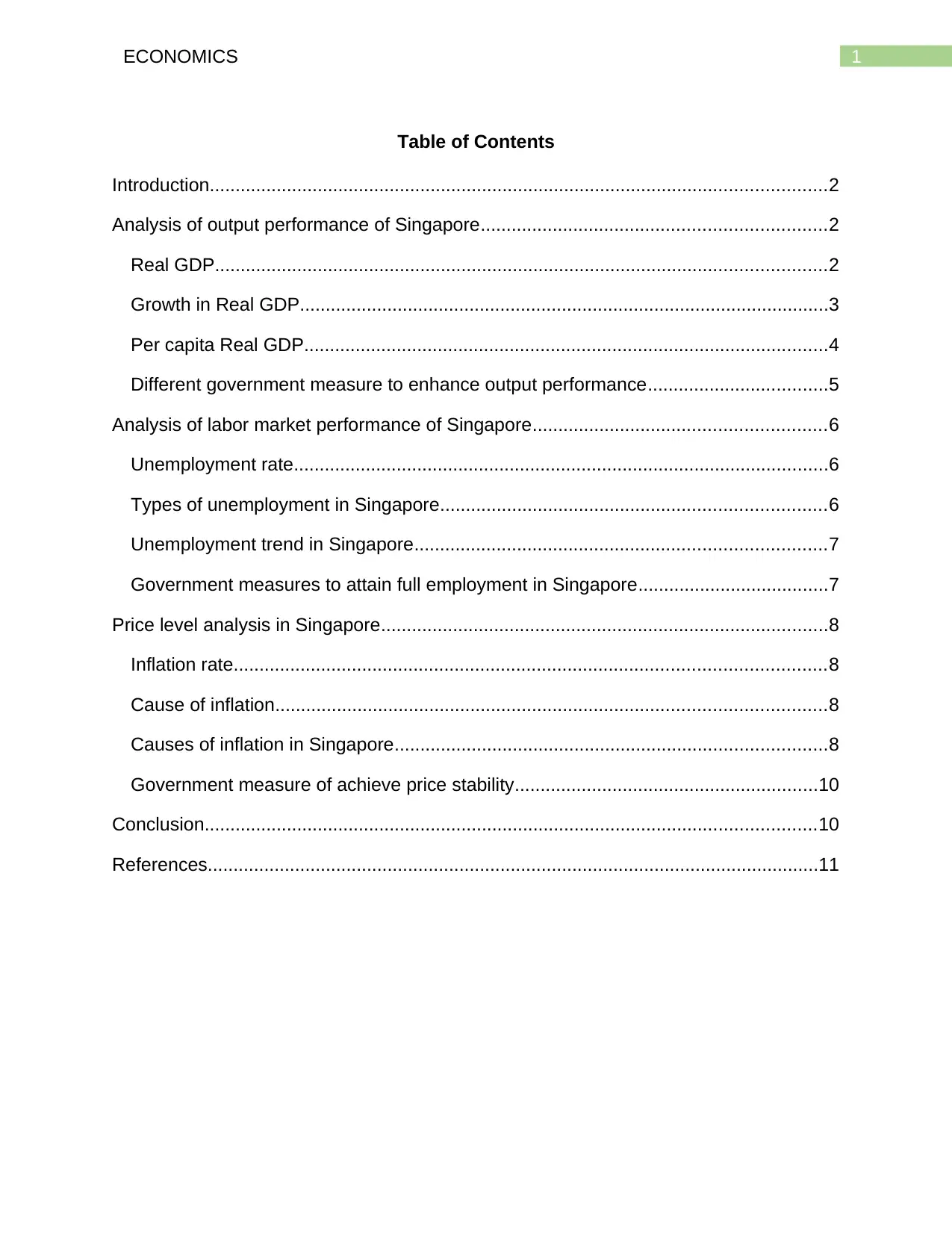
1ECONOMICS
Table of Contents
Introduction........................................................................................................................2
Analysis of output performance of Singapore...................................................................2
Real GDP.......................................................................................................................2
Growth in Real GDP.......................................................................................................3
Per capita Real GDP......................................................................................................4
Different government measure to enhance output performance...................................5
Analysis of labor market performance of Singapore.........................................................6
Unemployment rate........................................................................................................6
Types of unemployment in Singapore...........................................................................6
Unemployment trend in Singapore................................................................................7
Government measures to attain full employment in Singapore.....................................7
Price level analysis in Singapore.......................................................................................8
Inflation rate...................................................................................................................8
Cause of inflation...........................................................................................................8
Causes of inflation in Singapore....................................................................................8
Government measure of achieve price stability...........................................................10
Conclusion.......................................................................................................................10
References.......................................................................................................................11
Table of Contents
Introduction........................................................................................................................2
Analysis of output performance of Singapore...................................................................2
Real GDP.......................................................................................................................2
Growth in Real GDP.......................................................................................................3
Per capita Real GDP......................................................................................................4
Different government measure to enhance output performance...................................5
Analysis of labor market performance of Singapore.........................................................6
Unemployment rate........................................................................................................6
Types of unemployment in Singapore...........................................................................6
Unemployment trend in Singapore................................................................................7
Government measures to attain full employment in Singapore.....................................7
Price level analysis in Singapore.......................................................................................8
Inflation rate...................................................................................................................8
Cause of inflation...........................................................................................................8
Causes of inflation in Singapore....................................................................................8
Government measure of achieve price stability...........................................................10
Conclusion.......................................................................................................................10
References.......................................................................................................................11
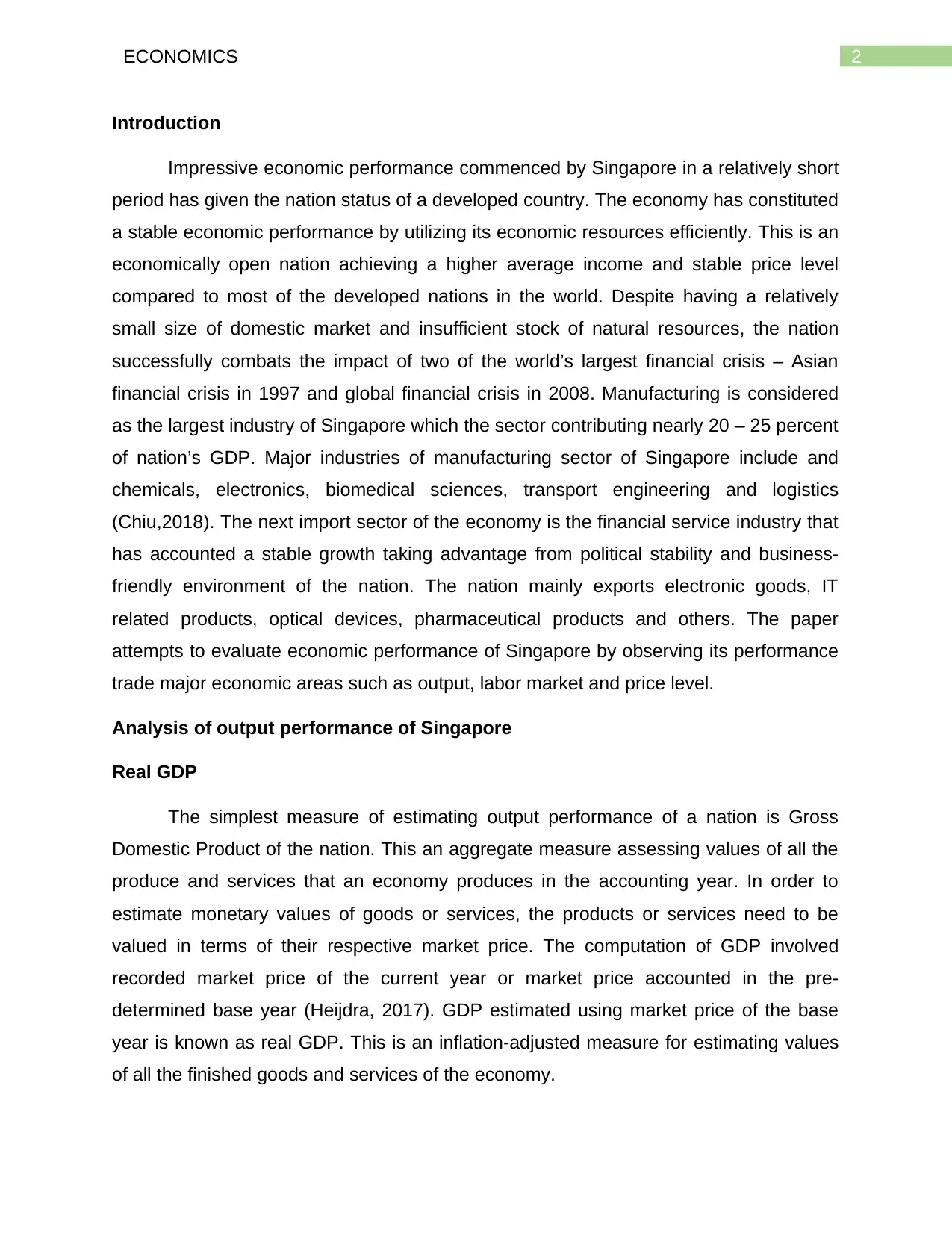
2ECONOMICS
Introduction
Impressive economic performance commenced by Singapore in a relatively short
period has given the nation status of a developed country. The economy has constituted
a stable economic performance by utilizing its economic resources efficiently. This is an
economically open nation achieving a higher average income and stable price level
compared to most of the developed nations in the world. Despite having a relatively
small size of domestic market and insufficient stock of natural resources, the nation
successfully combats the impact of two of the world’s largest financial crisis – Asian
financial crisis in 1997 and global financial crisis in 2008. Manufacturing is considered
as the largest industry of Singapore which the sector contributing nearly 20 – 25 percent
of nation’s GDP. Major industries of manufacturing sector of Singapore include and
chemicals, electronics, biomedical sciences, transport engineering and logistics
(Chiu,2018). The next import sector of the economy is the financial service industry that
has accounted a stable growth taking advantage from political stability and business-
friendly environment of the nation. The nation mainly exports electronic goods, IT
related products, optical devices, pharmaceutical products and others. The paper
attempts to evaluate economic performance of Singapore by observing its performance
trade major economic areas such as output, labor market and price level.
Analysis of output performance of Singapore
Real GDP
The simplest measure of estimating output performance of a nation is Gross
Domestic Product of the nation. This an aggregate measure assessing values of all the
produce and services that an economy produces in the accounting year. In order to
estimate monetary values of goods or services, the products or services need to be
valued in terms of their respective market price. The computation of GDP involved
recorded market price of the current year or market price accounted in the pre-
determined base year (Heijdra, 2017). GDP estimated using market price of the base
year is known as real GDP. This is an inflation-adjusted measure for estimating values
of all the finished goods and services of the economy.
Introduction
Impressive economic performance commenced by Singapore in a relatively short
period has given the nation status of a developed country. The economy has constituted
a stable economic performance by utilizing its economic resources efficiently. This is an
economically open nation achieving a higher average income and stable price level
compared to most of the developed nations in the world. Despite having a relatively
small size of domestic market and insufficient stock of natural resources, the nation
successfully combats the impact of two of the world’s largest financial crisis – Asian
financial crisis in 1997 and global financial crisis in 2008. Manufacturing is considered
as the largest industry of Singapore which the sector contributing nearly 20 – 25 percent
of nation’s GDP. Major industries of manufacturing sector of Singapore include and
chemicals, electronics, biomedical sciences, transport engineering and logistics
(Chiu,2018). The next import sector of the economy is the financial service industry that
has accounted a stable growth taking advantage from political stability and business-
friendly environment of the nation. The nation mainly exports electronic goods, IT
related products, optical devices, pharmaceutical products and others. The paper
attempts to evaluate economic performance of Singapore by observing its performance
trade major economic areas such as output, labor market and price level.
Analysis of output performance of Singapore
Real GDP
The simplest measure of estimating output performance of a nation is Gross
Domestic Product of the nation. This an aggregate measure assessing values of all the
produce and services that an economy produces in the accounting year. In order to
estimate monetary values of goods or services, the products or services need to be
valued in terms of their respective market price. The computation of GDP involved
recorded market price of the current year or market price accounted in the pre-
determined base year (Heijdra, 2017). GDP estimated using market price of the base
year is known as real GDP. This is an inflation-adjusted measure for estimating values
of all the finished goods and services of the economy.
⊘ This is a preview!⊘
Do you want full access?
Subscribe today to unlock all pages.

Trusted by 1+ million students worldwide
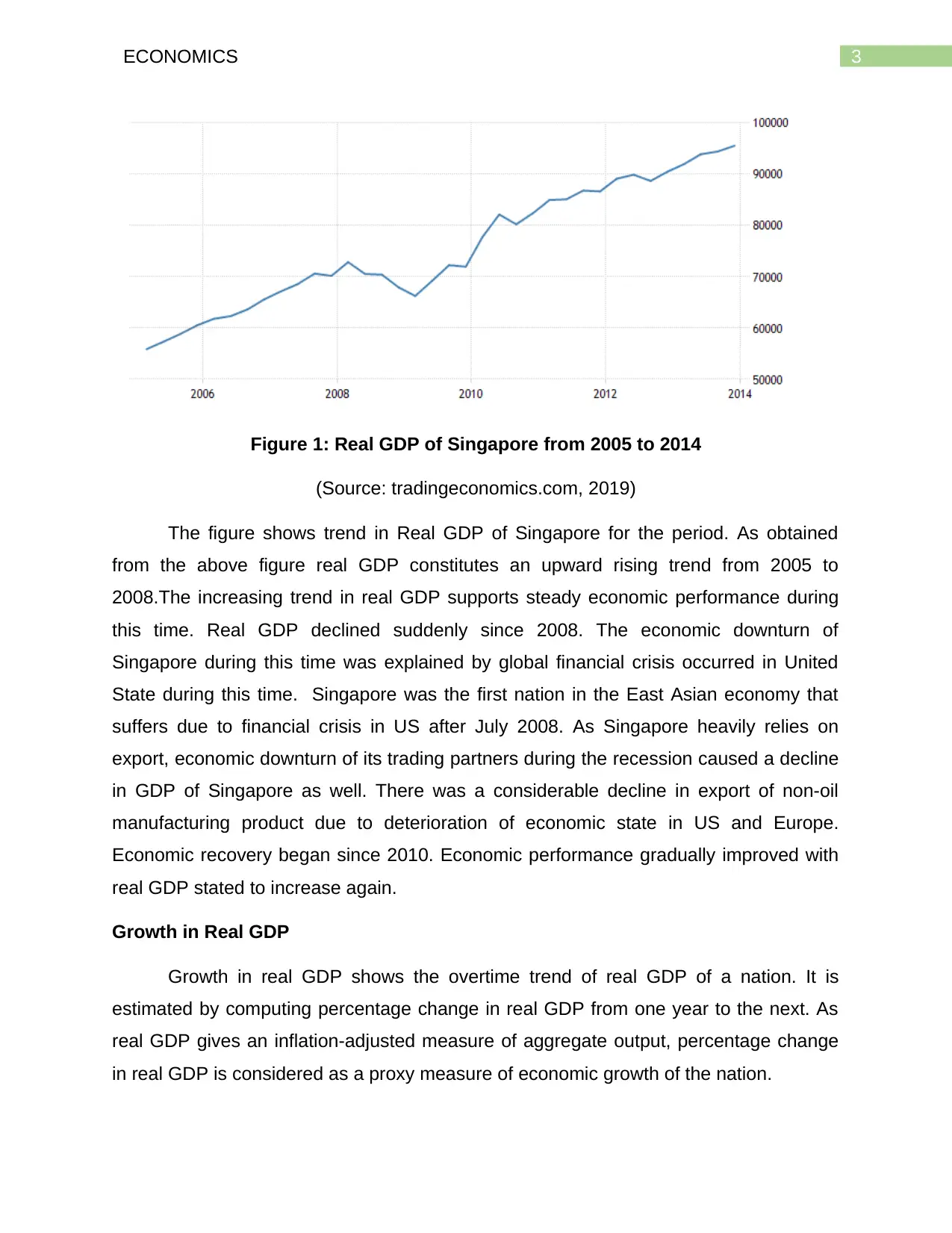
3ECONOMICS
Figure 1: Real GDP of Singapore from 2005 to 2014
(Source: tradingeconomics.com, 2019)
The figure shows trend in Real GDP of Singapore for the period. As obtained
from the above figure real GDP constitutes an upward rising trend from 2005 to
2008.The increasing trend in real GDP supports steady economic performance during
this time. Real GDP declined suddenly since 2008. The economic downturn of
Singapore during this time was explained by global financial crisis occurred in United
State during this time. Singapore was the first nation in the East Asian economy that
suffers due to financial crisis in US after July 2008. As Singapore heavily relies on
export, economic downturn of its trading partners during the recession caused a decline
in GDP of Singapore as well. There was a considerable decline in export of non-oil
manufacturing product due to deterioration of economic state in US and Europe.
Economic recovery began since 2010. Economic performance gradually improved with
real GDP stated to increase again.
Growth in Real GDP
Growth in real GDP shows the overtime trend of real GDP of a nation. It is
estimated by computing percentage change in real GDP from one year to the next. As
real GDP gives an inflation-adjusted measure of aggregate output, percentage change
in real GDP is considered as a proxy measure of economic growth of the nation.
Figure 1: Real GDP of Singapore from 2005 to 2014
(Source: tradingeconomics.com, 2019)
The figure shows trend in Real GDP of Singapore for the period. As obtained
from the above figure real GDP constitutes an upward rising trend from 2005 to
2008.The increasing trend in real GDP supports steady economic performance during
this time. Real GDP declined suddenly since 2008. The economic downturn of
Singapore during this time was explained by global financial crisis occurred in United
State during this time. Singapore was the first nation in the East Asian economy that
suffers due to financial crisis in US after July 2008. As Singapore heavily relies on
export, economic downturn of its trading partners during the recession caused a decline
in GDP of Singapore as well. There was a considerable decline in export of non-oil
manufacturing product due to deterioration of economic state in US and Europe.
Economic recovery began since 2010. Economic performance gradually improved with
real GDP stated to increase again.
Growth in Real GDP
Growth in real GDP shows the overtime trend of real GDP of a nation. It is
estimated by computing percentage change in real GDP from one year to the next. As
real GDP gives an inflation-adjusted measure of aggregate output, percentage change
in real GDP is considered as a proxy measure of economic growth of the nation.
Paraphrase This Document
Need a fresh take? Get an instant paraphrase of this document with our AI Paraphraser
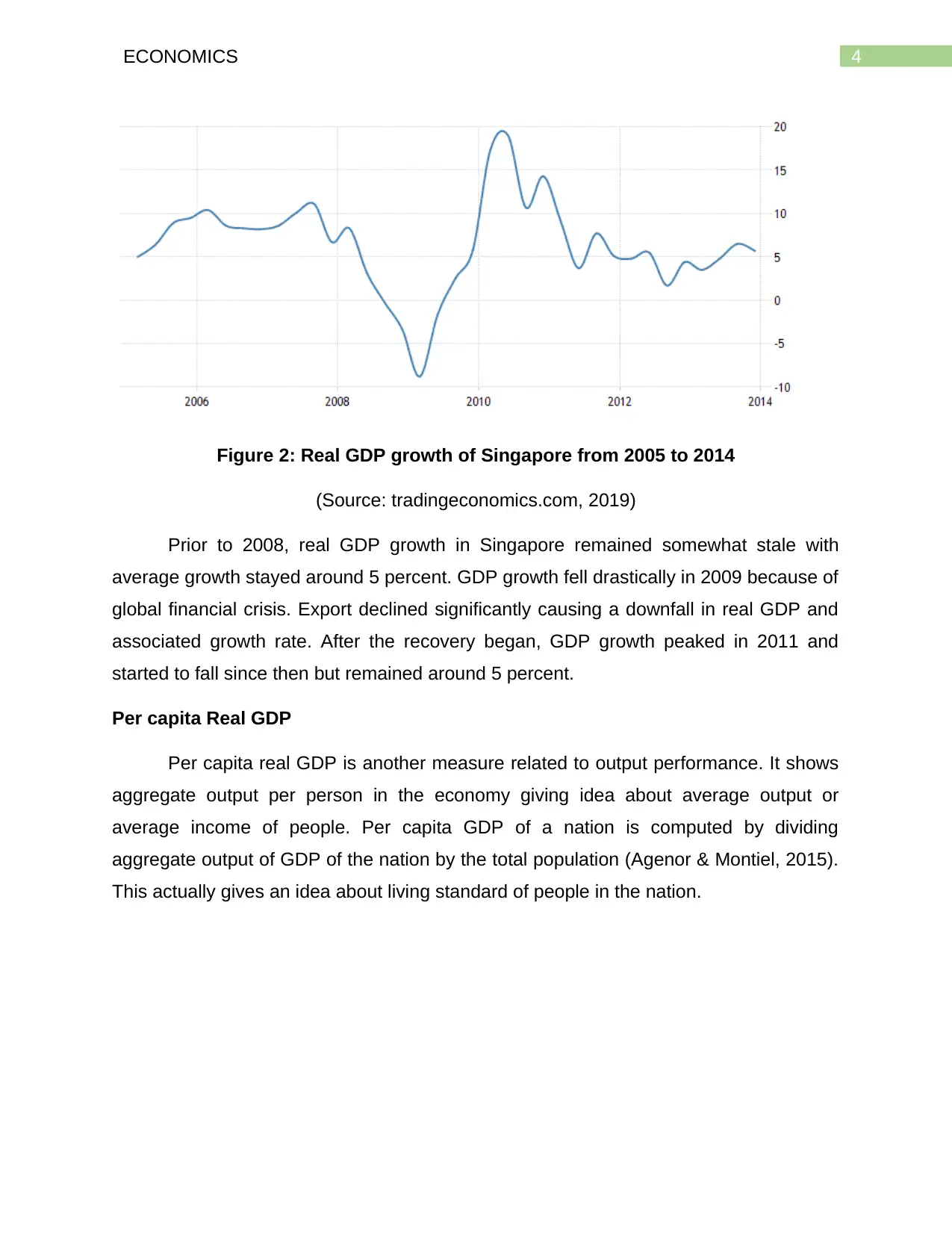
4ECONOMICS
Figure 2: Real GDP growth of Singapore from 2005 to 2014
(Source: tradingeconomics.com, 2019)
Prior to 2008, real GDP growth in Singapore remained somewhat stale with
average growth stayed around 5 percent. GDP growth fell drastically in 2009 because of
global financial crisis. Export declined significantly causing a downfall in real GDP and
associated growth rate. After the recovery began, GDP growth peaked in 2011 and
started to fall since then but remained around 5 percent.
Per capita Real GDP
Per capita real GDP is another measure related to output performance. It shows
aggregate output per person in the economy giving idea about average output or
average income of people. Per capita GDP of a nation is computed by dividing
aggregate output of GDP of the nation by the total population (Agenor & Montiel, 2015).
This actually gives an idea about living standard of people in the nation.
Figure 2: Real GDP growth of Singapore from 2005 to 2014
(Source: tradingeconomics.com, 2019)
Prior to 2008, real GDP growth in Singapore remained somewhat stale with
average growth stayed around 5 percent. GDP growth fell drastically in 2009 because of
global financial crisis. Export declined significantly causing a downfall in real GDP and
associated growth rate. After the recovery began, GDP growth peaked in 2011 and
started to fall since then but remained around 5 percent.
Per capita Real GDP
Per capita real GDP is another measure related to output performance. It shows
aggregate output per person in the economy giving idea about average output or
average income of people. Per capita GDP of a nation is computed by dividing
aggregate output of GDP of the nation by the total population (Agenor & Montiel, 2015).
This actually gives an idea about living standard of people in the nation.
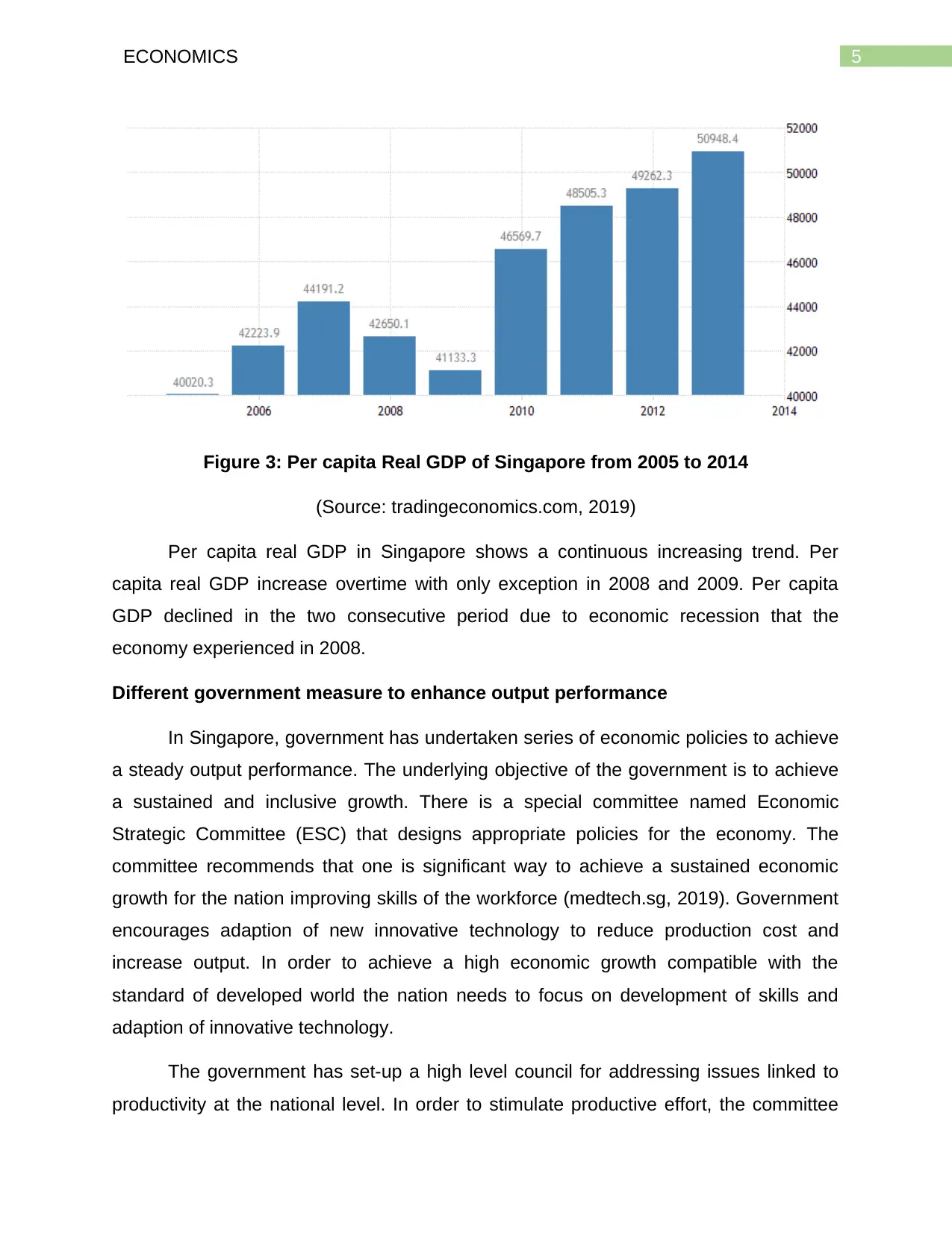
5ECONOMICS
Figure 3: Per capita Real GDP of Singapore from 2005 to 2014
(Source: tradingeconomics.com, 2019)
Per capita real GDP in Singapore shows a continuous increasing trend. Per
capita real GDP increase overtime with only exception in 2008 and 2009. Per capita
GDP declined in the two consecutive period due to economic recession that the
economy experienced in 2008.
Different government measure to enhance output performance
In Singapore, government has undertaken series of economic policies to achieve
a steady output performance. The underlying objective of the government is to achieve
a sustained and inclusive growth. There is a special committee named Economic
Strategic Committee (ESC) that designs appropriate policies for the economy. The
committee recommends that one is significant way to achieve a sustained economic
growth for the nation improving skills of the workforce (medtech.sg, 2019). Government
encourages adaption of new innovative technology to reduce production cost and
increase output. In order to achieve a high economic growth compatible with the
standard of developed world the nation needs to focus on development of skills and
adaption of innovative technology.
The government has set-up a high level council for addressing issues linked to
productivity at the national level. In order to stimulate productive effort, the committee
Figure 3: Per capita Real GDP of Singapore from 2005 to 2014
(Source: tradingeconomics.com, 2019)
Per capita real GDP in Singapore shows a continuous increasing trend. Per
capita real GDP increase overtime with only exception in 2008 and 2009. Per capita
GDP declined in the two consecutive period due to economic recession that the
economy experienced in 2008.
Different government measure to enhance output performance
In Singapore, government has undertaken series of economic policies to achieve
a steady output performance. The underlying objective of the government is to achieve
a sustained and inclusive growth. There is a special committee named Economic
Strategic Committee (ESC) that designs appropriate policies for the economy. The
committee recommends that one is significant way to achieve a sustained economic
growth for the nation improving skills of the workforce (medtech.sg, 2019). Government
encourages adaption of new innovative technology to reduce production cost and
increase output. In order to achieve a high economic growth compatible with the
standard of developed world the nation needs to focus on development of skills and
adaption of innovative technology.
The government has set-up a high level council for addressing issues linked to
productivity at the national level. In order to stimulate productive effort, the committee
⊘ This is a preview!⊘
Do you want full access?
Subscribe today to unlock all pages.

Trusted by 1+ million students worldwide
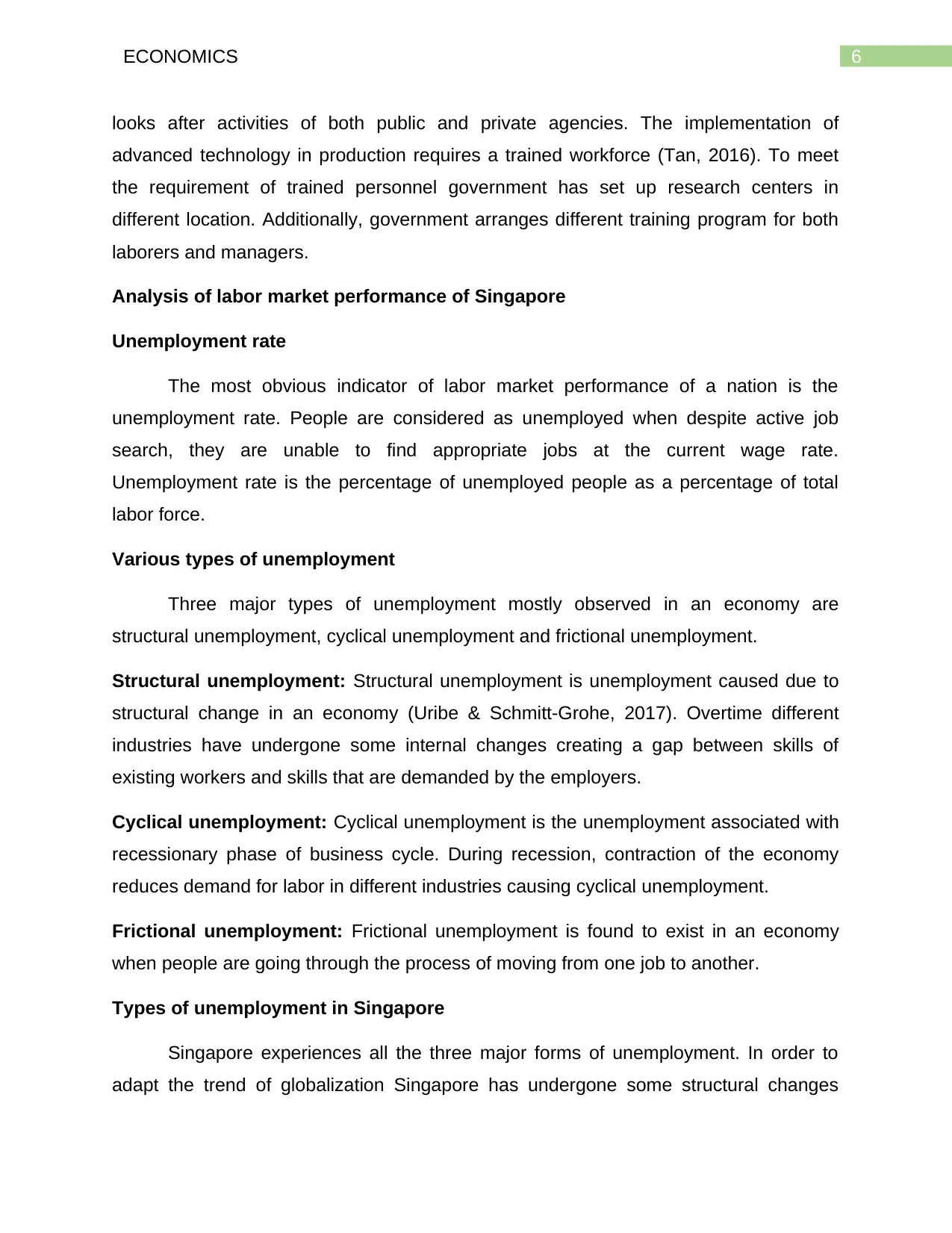
6ECONOMICS
looks after activities of both public and private agencies. The implementation of
advanced technology in production requires a trained workforce (Tan, 2016). To meet
the requirement of trained personnel government has set up research centers in
different location. Additionally, government arranges different training program for both
laborers and managers.
Analysis of labor market performance of Singapore
Unemployment rate
The most obvious indicator of labor market performance of a nation is the
unemployment rate. People are considered as unemployed when despite active job
search, they are unable to find appropriate jobs at the current wage rate.
Unemployment rate is the percentage of unemployed people as a percentage of total
labor force.
Various types of unemployment
Three major types of unemployment mostly observed in an economy are
structural unemployment, cyclical unemployment and frictional unemployment.
Structural unemployment: Structural unemployment is unemployment caused due to
structural change in an economy (Uribe & Schmitt-Grohe, 2017). Overtime different
industries have undergone some internal changes creating a gap between skills of
existing workers and skills that are demanded by the employers.
Cyclical unemployment: Cyclical unemployment is the unemployment associated with
recessionary phase of business cycle. During recession, contraction of the economy
reduces demand for labor in different industries causing cyclical unemployment.
Frictional unemployment: Frictional unemployment is found to exist in an economy
when people are going through the process of moving from one job to another.
Types of unemployment in Singapore
Singapore experiences all the three major forms of unemployment. In order to
adapt the trend of globalization Singapore has undergone some structural changes
looks after activities of both public and private agencies. The implementation of
advanced technology in production requires a trained workforce (Tan, 2016). To meet
the requirement of trained personnel government has set up research centers in
different location. Additionally, government arranges different training program for both
laborers and managers.
Analysis of labor market performance of Singapore
Unemployment rate
The most obvious indicator of labor market performance of a nation is the
unemployment rate. People are considered as unemployed when despite active job
search, they are unable to find appropriate jobs at the current wage rate.
Unemployment rate is the percentage of unemployed people as a percentage of total
labor force.
Various types of unemployment
Three major types of unemployment mostly observed in an economy are
structural unemployment, cyclical unemployment and frictional unemployment.
Structural unemployment: Structural unemployment is unemployment caused due to
structural change in an economy (Uribe & Schmitt-Grohe, 2017). Overtime different
industries have undergone some internal changes creating a gap between skills of
existing workers and skills that are demanded by the employers.
Cyclical unemployment: Cyclical unemployment is the unemployment associated with
recessionary phase of business cycle. During recession, contraction of the economy
reduces demand for labor in different industries causing cyclical unemployment.
Frictional unemployment: Frictional unemployment is found to exist in an economy
when people are going through the process of moving from one job to another.
Types of unemployment in Singapore
Singapore experiences all the three major forms of unemployment. In order to
adapt the trend of globalization Singapore has undergone some structural changes
Paraphrase This Document
Need a fresh take? Get an instant paraphrase of this document with our AI Paraphraser
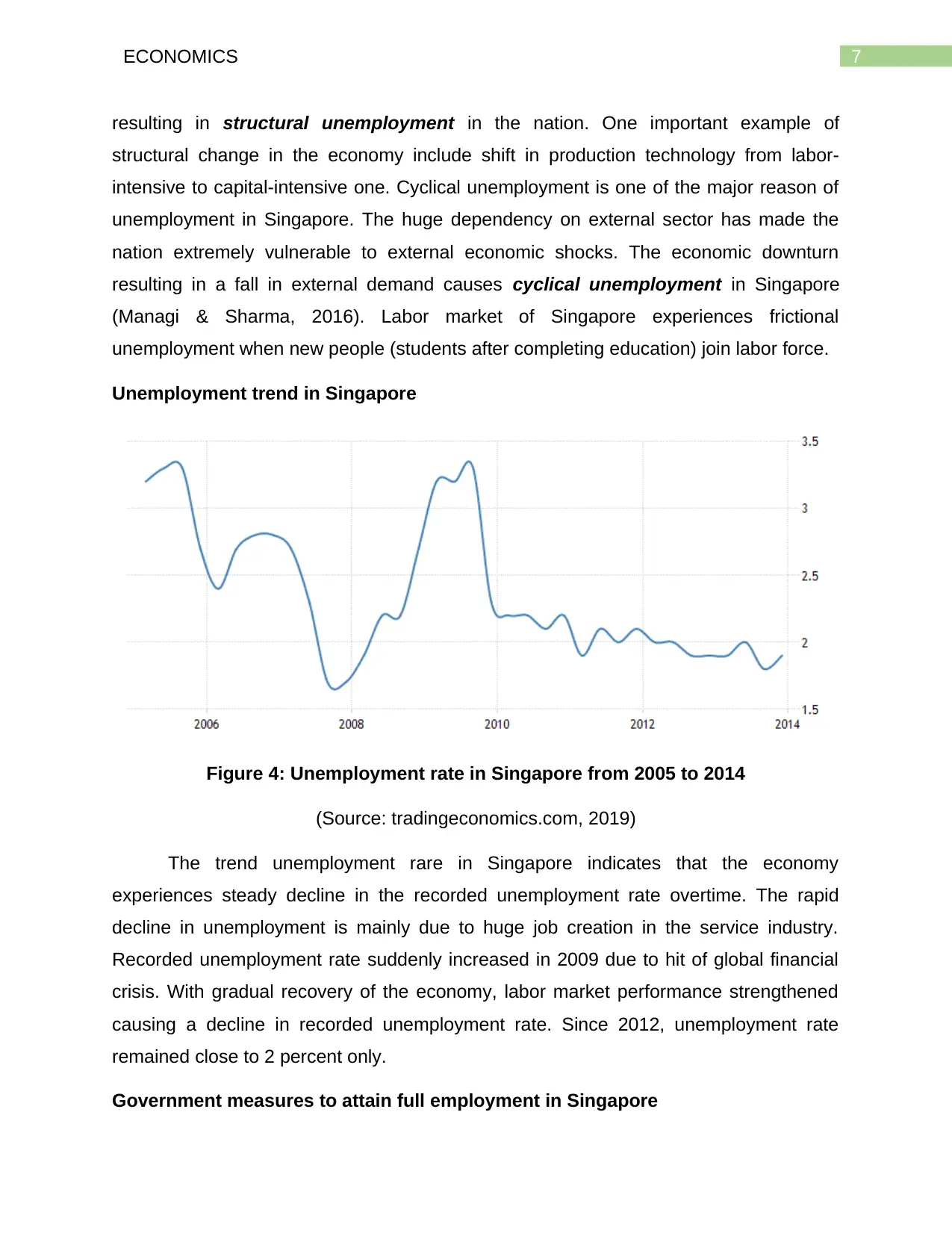
7ECONOMICS
resulting in structural unemployment in the nation. One important example of
structural change in the economy include shift in production technology from labor-
intensive to capital-intensive one. Cyclical unemployment is one of the major reason of
unemployment in Singapore. The huge dependency on external sector has made the
nation extremely vulnerable to external economic shocks. The economic downturn
resulting in a fall in external demand causes cyclical unemployment in Singapore
(Managi & Sharma, 2016). Labor market of Singapore experiences frictional
unemployment when new people (students after completing education) join labor force.
Unemployment trend in Singapore
Figure 4: Unemployment rate in Singapore from 2005 to 2014
(Source: tradingeconomics.com, 2019)
The trend unemployment rare in Singapore indicates that the economy
experiences steady decline in the recorded unemployment rate overtime. The rapid
decline in unemployment is mainly due to huge job creation in the service industry.
Recorded unemployment rate suddenly increased in 2009 due to hit of global financial
crisis. With gradual recovery of the economy, labor market performance strengthened
causing a decline in recorded unemployment rate. Since 2012, unemployment rate
remained close to 2 percent only.
Government measures to attain full employment in Singapore
resulting in structural unemployment in the nation. One important example of
structural change in the economy include shift in production technology from labor-
intensive to capital-intensive one. Cyclical unemployment is one of the major reason of
unemployment in Singapore. The huge dependency on external sector has made the
nation extremely vulnerable to external economic shocks. The economic downturn
resulting in a fall in external demand causes cyclical unemployment in Singapore
(Managi & Sharma, 2016). Labor market of Singapore experiences frictional
unemployment when new people (students after completing education) join labor force.
Unemployment trend in Singapore
Figure 4: Unemployment rate in Singapore from 2005 to 2014
(Source: tradingeconomics.com, 2019)
The trend unemployment rare in Singapore indicates that the economy
experiences steady decline in the recorded unemployment rate overtime. The rapid
decline in unemployment is mainly due to huge job creation in the service industry.
Recorded unemployment rate suddenly increased in 2009 due to hit of global financial
crisis. With gradual recovery of the economy, labor market performance strengthened
causing a decline in recorded unemployment rate. Since 2012, unemployment rate
remained close to 2 percent only.
Government measures to attain full employment in Singapore
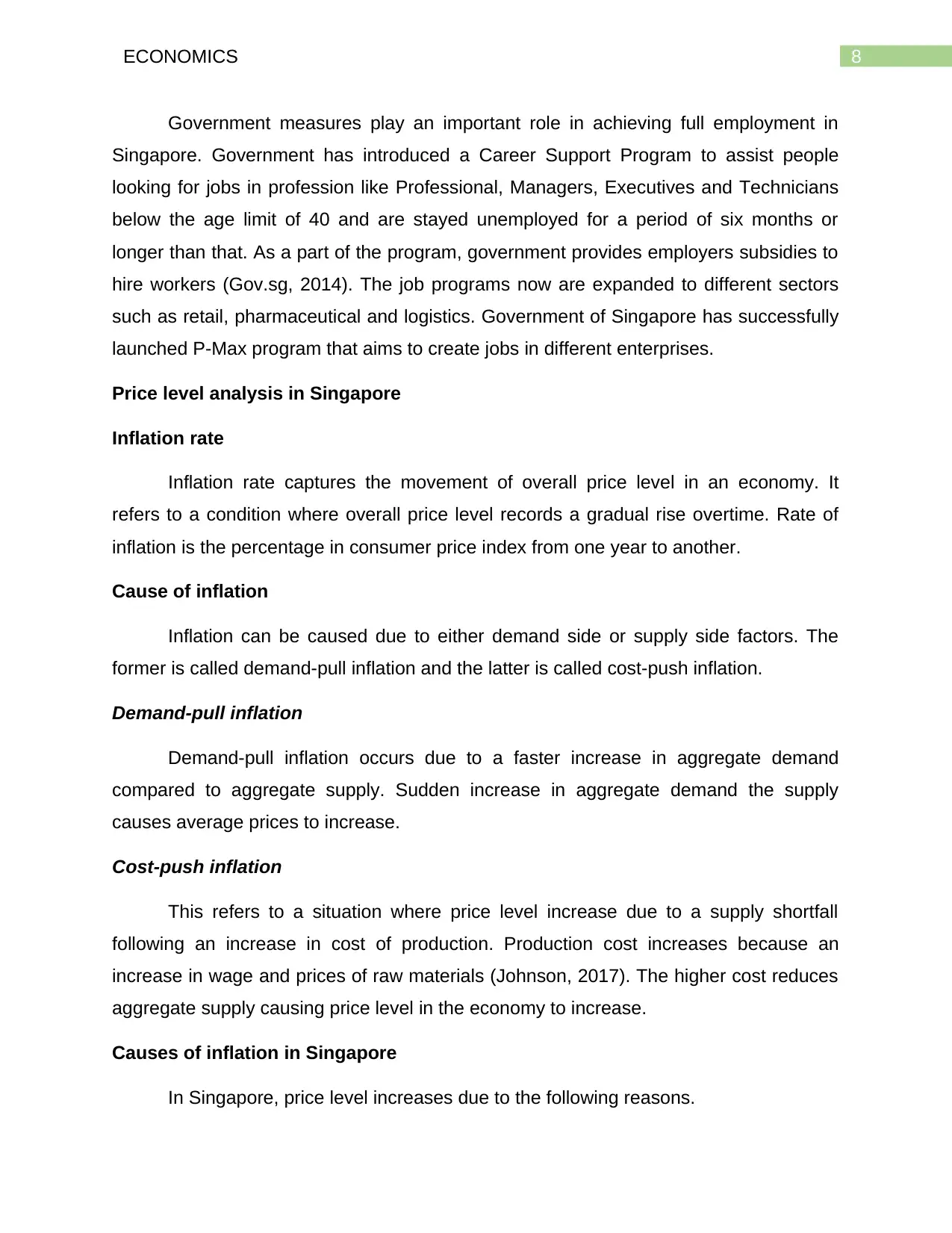
8ECONOMICS
Government measures play an important role in achieving full employment in
Singapore. Government has introduced a Career Support Program to assist people
looking for jobs in profession like Professional, Managers, Executives and Technicians
below the age limit of 40 and are stayed unemployed for a period of six months or
longer than that. As a part of the program, government provides employers subsidies to
hire workers (Gov.sg, 2014). The job programs now are expanded to different sectors
such as retail, pharmaceutical and logistics. Government of Singapore has successfully
launched P-Max program that aims to create jobs in different enterprises.
Price level analysis in Singapore
Inflation rate
Inflation rate captures the movement of overall price level in an economy. It
refers to a condition where overall price level records a gradual rise overtime. Rate of
inflation is the percentage in consumer price index from one year to another.
Cause of inflation
Inflation can be caused due to either demand side or supply side factors. The
former is called demand-pull inflation and the latter is called cost-push inflation.
Demand-pull inflation
Demand-pull inflation occurs due to a faster increase in aggregate demand
compared to aggregate supply. Sudden increase in aggregate demand the supply
causes average prices to increase.
Cost-push inflation
This refers to a situation where price level increase due to a supply shortfall
following an increase in cost of production. Production cost increases because an
increase in wage and prices of raw materials (Johnson, 2017). The higher cost reduces
aggregate supply causing price level in the economy to increase.
Causes of inflation in Singapore
In Singapore, price level increases due to the following reasons.
Government measures play an important role in achieving full employment in
Singapore. Government has introduced a Career Support Program to assist people
looking for jobs in profession like Professional, Managers, Executives and Technicians
below the age limit of 40 and are stayed unemployed for a period of six months or
longer than that. As a part of the program, government provides employers subsidies to
hire workers (Gov.sg, 2014). The job programs now are expanded to different sectors
such as retail, pharmaceutical and logistics. Government of Singapore has successfully
launched P-Max program that aims to create jobs in different enterprises.
Price level analysis in Singapore
Inflation rate
Inflation rate captures the movement of overall price level in an economy. It
refers to a condition where overall price level records a gradual rise overtime. Rate of
inflation is the percentage in consumer price index from one year to another.
Cause of inflation
Inflation can be caused due to either demand side or supply side factors. The
former is called demand-pull inflation and the latter is called cost-push inflation.
Demand-pull inflation
Demand-pull inflation occurs due to a faster increase in aggregate demand
compared to aggregate supply. Sudden increase in aggregate demand the supply
causes average prices to increase.
Cost-push inflation
This refers to a situation where price level increase due to a supply shortfall
following an increase in cost of production. Production cost increases because an
increase in wage and prices of raw materials (Johnson, 2017). The higher cost reduces
aggregate supply causing price level in the economy to increase.
Causes of inflation in Singapore
In Singapore, price level increases due to the following reasons.
⊘ This is a preview!⊘
Do you want full access?
Subscribe today to unlock all pages.

Trusted by 1+ million students worldwide
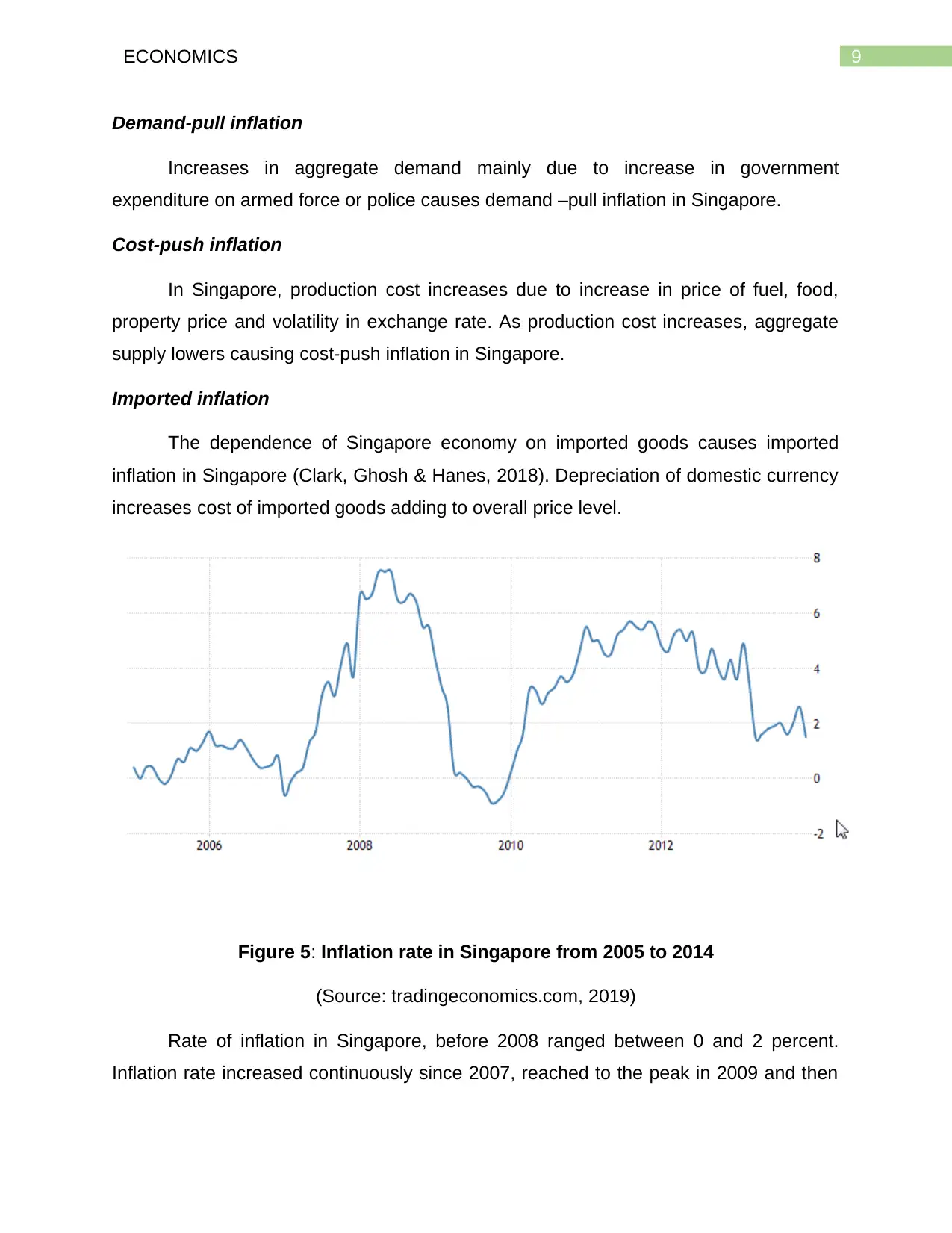
9ECONOMICS
Demand-pull inflation
Increases in aggregate demand mainly due to increase in government
expenditure on armed force or police causes demand –pull inflation in Singapore.
Cost-push inflation
In Singapore, production cost increases due to increase in price of fuel, food,
property price and volatility in exchange rate. As production cost increases, aggregate
supply lowers causing cost-push inflation in Singapore.
Imported inflation
The dependence of Singapore economy on imported goods causes imported
inflation in Singapore (Clark, Ghosh & Hanes, 2018). Depreciation of domestic currency
increases cost of imported goods adding to overall price level.
Figure 5: Inflation rate in Singapore from 2005 to 2014
(Source: tradingeconomics.com, 2019)
Rate of inflation in Singapore, before 2008 ranged between 0 and 2 percent.
Inflation rate increased continuously since 2007, reached to the peak in 2009 and then
Demand-pull inflation
Increases in aggregate demand mainly due to increase in government
expenditure on armed force or police causes demand –pull inflation in Singapore.
Cost-push inflation
In Singapore, production cost increases due to increase in price of fuel, food,
property price and volatility in exchange rate. As production cost increases, aggregate
supply lowers causing cost-push inflation in Singapore.
Imported inflation
The dependence of Singapore economy on imported goods causes imported
inflation in Singapore (Clark, Ghosh & Hanes, 2018). Depreciation of domestic currency
increases cost of imported goods adding to overall price level.
Figure 5: Inflation rate in Singapore from 2005 to 2014
(Source: tradingeconomics.com, 2019)
Rate of inflation in Singapore, before 2008 ranged between 0 and 2 percent.
Inflation rate increased continuously since 2007, reached to the peak in 2009 and then
Paraphrase This Document
Need a fresh take? Get an instant paraphrase of this document with our AI Paraphraser
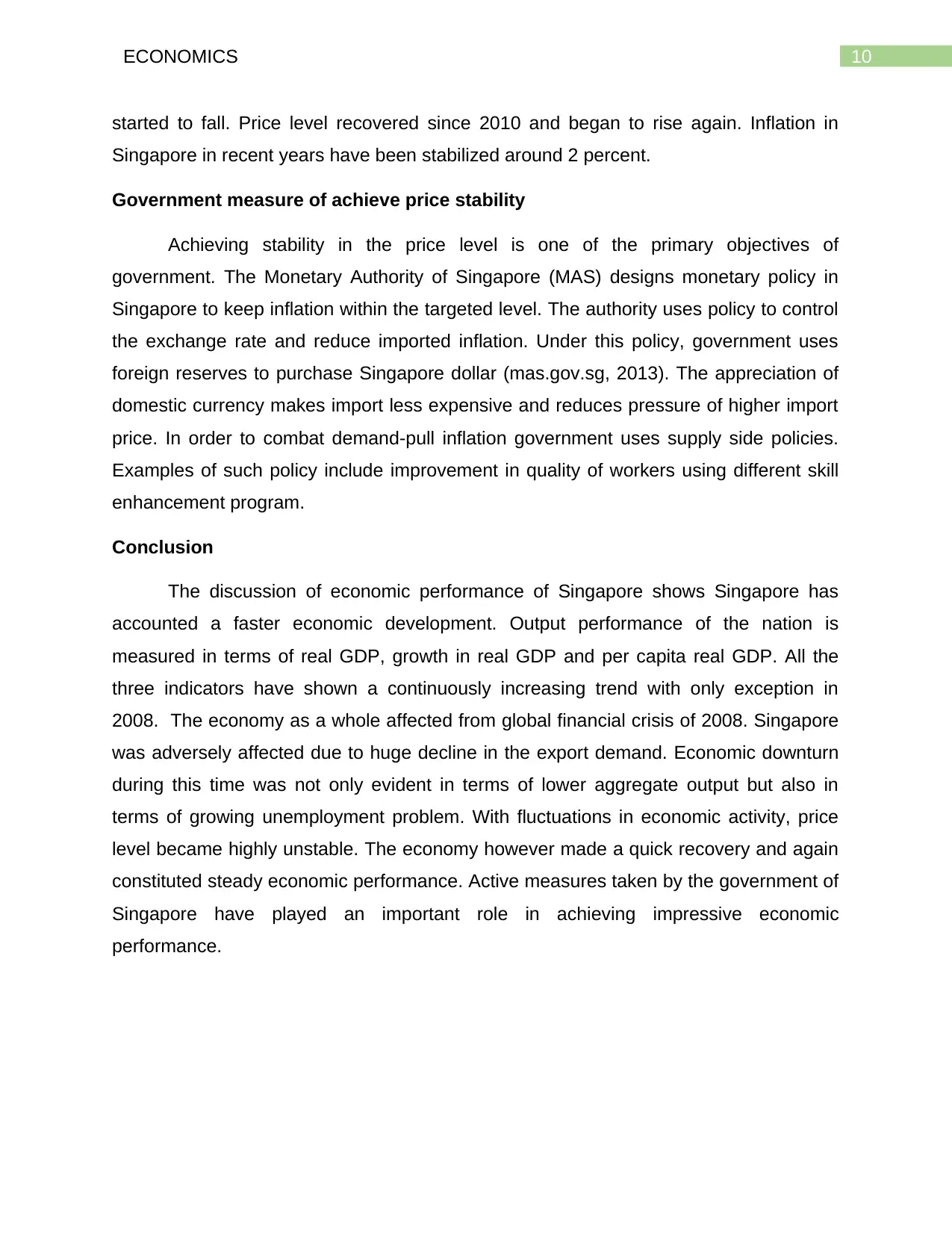
10ECONOMICS
started to fall. Price level recovered since 2010 and began to rise again. Inflation in
Singapore in recent years have been stabilized around 2 percent.
Government measure of achieve price stability
Achieving stability in the price level is one of the primary objectives of
government. The Monetary Authority of Singapore (MAS) designs monetary policy in
Singapore to keep inflation within the targeted level. The authority uses policy to control
the exchange rate and reduce imported inflation. Under this policy, government uses
foreign reserves to purchase Singapore dollar (mas.gov.sg, 2013). The appreciation of
domestic currency makes import less expensive and reduces pressure of higher import
price. In order to combat demand-pull inflation government uses supply side policies.
Examples of such policy include improvement in quality of workers using different skill
enhancement program.
Conclusion
The discussion of economic performance of Singapore shows Singapore has
accounted a faster economic development. Output performance of the nation is
measured in terms of real GDP, growth in real GDP and per capita real GDP. All the
three indicators have shown a continuously increasing trend with only exception in
2008. The economy as a whole affected from global financial crisis of 2008. Singapore
was adversely affected due to huge decline in the export demand. Economic downturn
during this time was not only evident in terms of lower aggregate output but also in
terms of growing unemployment problem. With fluctuations in economic activity, price
level became highly unstable. The economy however made a quick recovery and again
constituted steady economic performance. Active measures taken by the government of
Singapore have played an important role in achieving impressive economic
performance.
started to fall. Price level recovered since 2010 and began to rise again. Inflation in
Singapore in recent years have been stabilized around 2 percent.
Government measure of achieve price stability
Achieving stability in the price level is one of the primary objectives of
government. The Monetary Authority of Singapore (MAS) designs monetary policy in
Singapore to keep inflation within the targeted level. The authority uses policy to control
the exchange rate and reduce imported inflation. Under this policy, government uses
foreign reserves to purchase Singapore dollar (mas.gov.sg, 2013). The appreciation of
domestic currency makes import less expensive and reduces pressure of higher import
price. In order to combat demand-pull inflation government uses supply side policies.
Examples of such policy include improvement in quality of workers using different skill
enhancement program.
Conclusion
The discussion of economic performance of Singapore shows Singapore has
accounted a faster economic development. Output performance of the nation is
measured in terms of real GDP, growth in real GDP and per capita real GDP. All the
three indicators have shown a continuously increasing trend with only exception in
2008. The economy as a whole affected from global financial crisis of 2008. Singapore
was adversely affected due to huge decline in the export demand. Economic downturn
during this time was not only evident in terms of lower aggregate output but also in
terms of growing unemployment problem. With fluctuations in economic activity, price
level became highly unstable. The economy however made a quick recovery and again
constituted steady economic performance. Active measures taken by the government of
Singapore have played an important role in achieving impressive economic
performance.
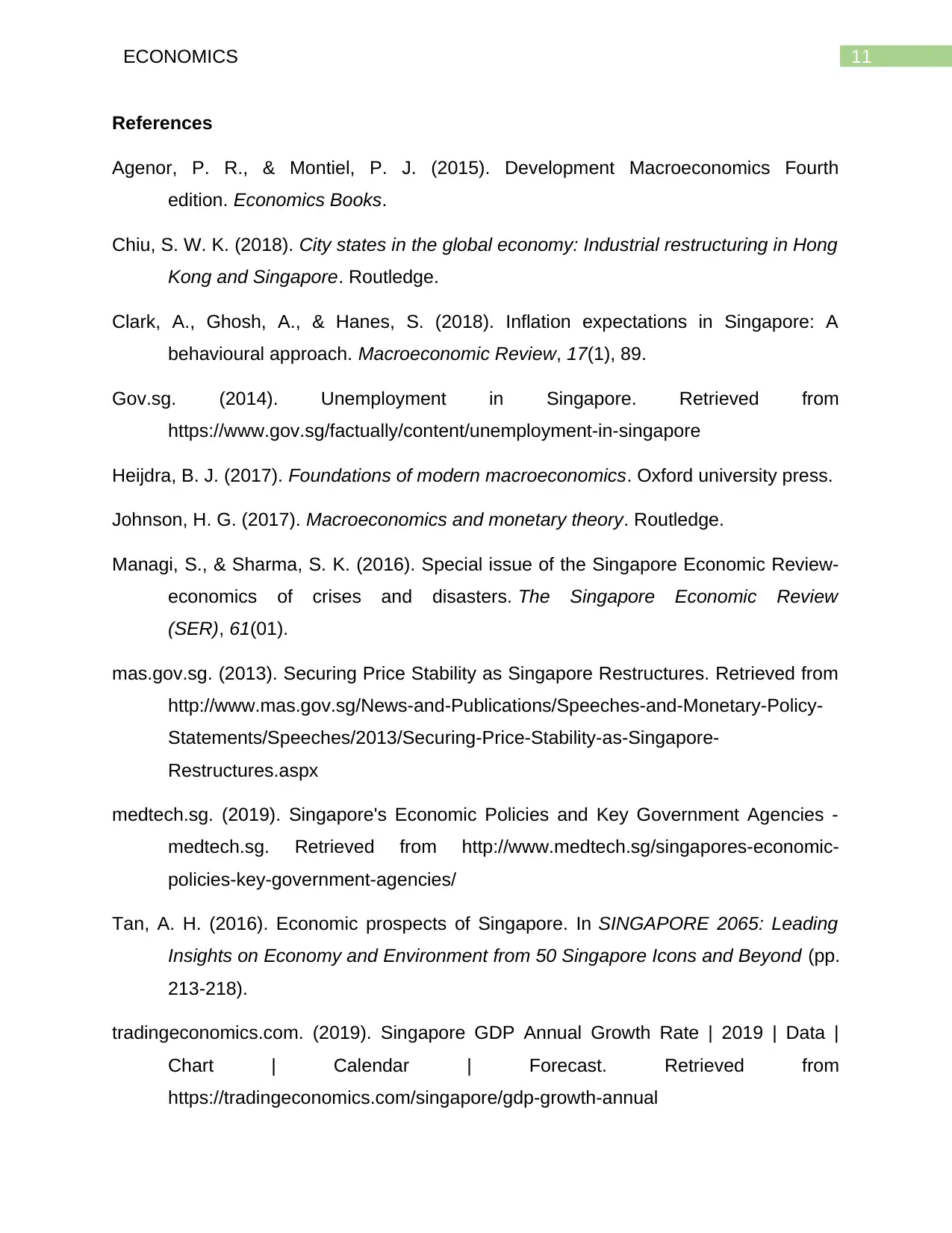
11ECONOMICS
References
Agenor, P. R., & Montiel, P. J. (2015). Development Macroeconomics Fourth
edition. Economics Books.
Chiu, S. W. K. (2018). City states in the global economy: Industrial restructuring in Hong
Kong and Singapore. Routledge.
Clark, A., Ghosh, A., & Hanes, S. (2018). Inflation expectations in Singapore: A
behavioural approach. Macroeconomic Review, 17(1), 89.
Gov.sg. (2014). Unemployment in Singapore. Retrieved from
https://www.gov.sg/factually/content/unemployment-in-singapore
Heijdra, B. J. (2017). Foundations of modern macroeconomics. Oxford university press.
Johnson, H. G. (2017). Macroeconomics and monetary theory. Routledge.
Managi, S., & Sharma, S. K. (2016). Special issue of the Singapore Economic Review-
economics of crises and disasters. The Singapore Economic Review
(SER), 61(01).
mas.gov.sg. (2013). Securing Price Stability as Singapore Restructures. Retrieved from
http://www.mas.gov.sg/News-and-Publications/Speeches-and-Monetary-Policy-
Statements/Speeches/2013/Securing-Price-Stability-as-Singapore-
Restructures.aspx
medtech.sg. (2019). Singapore's Economic Policies and Key Government Agencies -
medtech.sg. Retrieved from http://www.medtech.sg/singapores-economic-
policies-key-government-agencies/
Tan, A. H. (2016). Economic prospects of Singapore. In SINGAPORE 2065: Leading
Insights on Economy and Environment from 50 Singapore Icons and Beyond (pp.
213-218).
tradingeconomics.com. (2019). Singapore GDP Annual Growth Rate | 2019 | Data |
Chart | Calendar | Forecast. Retrieved from
https://tradingeconomics.com/singapore/gdp-growth-annual
References
Agenor, P. R., & Montiel, P. J. (2015). Development Macroeconomics Fourth
edition. Economics Books.
Chiu, S. W. K. (2018). City states in the global economy: Industrial restructuring in Hong
Kong and Singapore. Routledge.
Clark, A., Ghosh, A., & Hanes, S. (2018). Inflation expectations in Singapore: A
behavioural approach. Macroeconomic Review, 17(1), 89.
Gov.sg. (2014). Unemployment in Singapore. Retrieved from
https://www.gov.sg/factually/content/unemployment-in-singapore
Heijdra, B. J. (2017). Foundations of modern macroeconomics. Oxford university press.
Johnson, H. G. (2017). Macroeconomics and monetary theory. Routledge.
Managi, S., & Sharma, S. K. (2016). Special issue of the Singapore Economic Review-
economics of crises and disasters. The Singapore Economic Review
(SER), 61(01).
mas.gov.sg. (2013). Securing Price Stability as Singapore Restructures. Retrieved from
http://www.mas.gov.sg/News-and-Publications/Speeches-and-Monetary-Policy-
Statements/Speeches/2013/Securing-Price-Stability-as-Singapore-
Restructures.aspx
medtech.sg. (2019). Singapore's Economic Policies and Key Government Agencies -
medtech.sg. Retrieved from http://www.medtech.sg/singapores-economic-
policies-key-government-agencies/
Tan, A. H. (2016). Economic prospects of Singapore. In SINGAPORE 2065: Leading
Insights on Economy and Environment from 50 Singapore Icons and Beyond (pp.
213-218).
tradingeconomics.com. (2019). Singapore GDP Annual Growth Rate | 2019 | Data |
Chart | Calendar | Forecast. Retrieved from
https://tradingeconomics.com/singapore/gdp-growth-annual
⊘ This is a preview!⊘
Do you want full access?
Subscribe today to unlock all pages.

Trusted by 1+ million students worldwide
1 out of 13
Related Documents
Your All-in-One AI-Powered Toolkit for Academic Success.
+13062052269
info@desklib.com
Available 24*7 on WhatsApp / Email
![[object Object]](/_next/static/media/star-bottom.7253800d.svg)
Unlock your academic potential
Copyright © 2020–2026 A2Z Services. All Rights Reserved. Developed and managed by ZUCOL.




